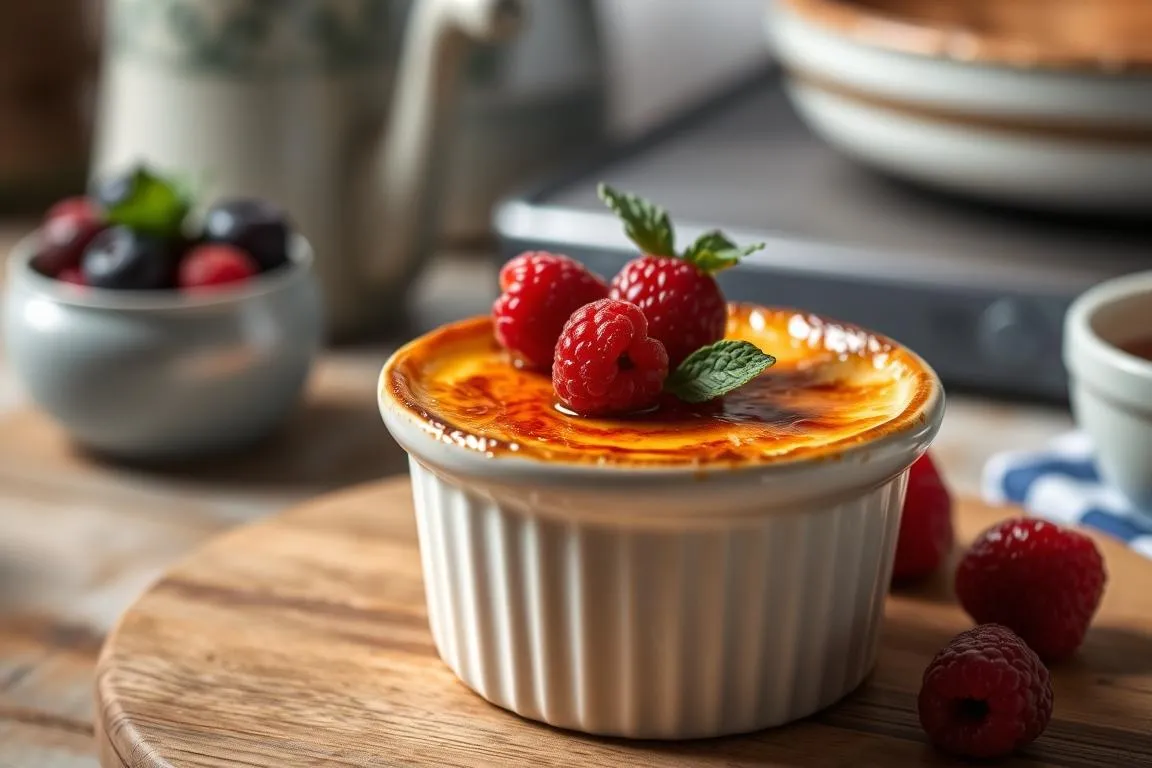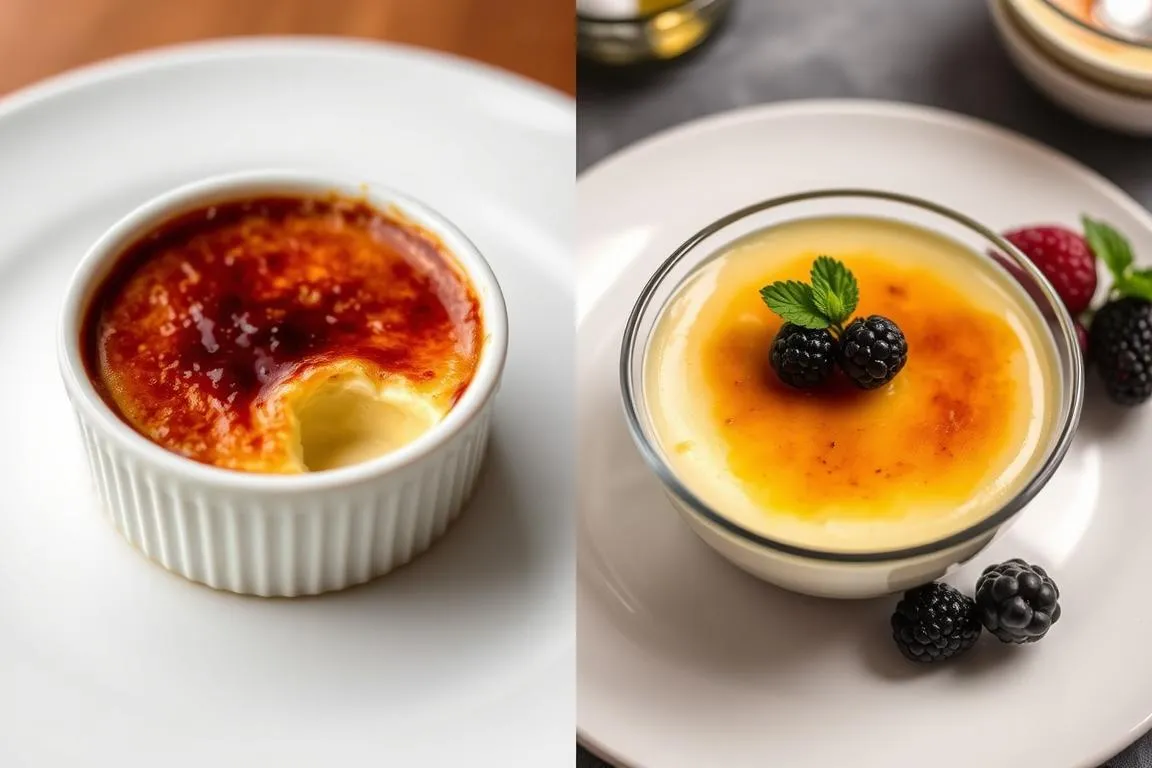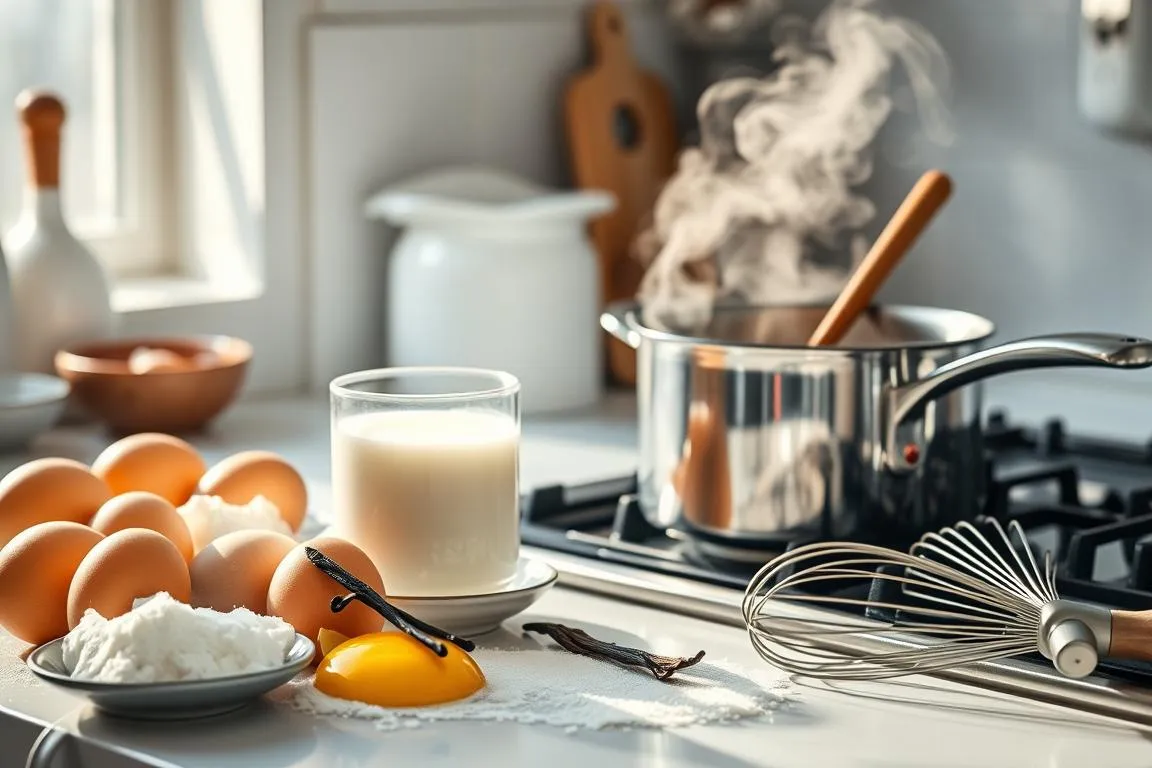What’s the difference between crème brûlée and custard .Explore the world of French desserts, where crème brûlée and custard are kings. They might look alike at first, but they have their own special qualities. Knowing the differences between custard desserts can make you a better baker.
Crème brûlée is a fancy French dessert known for its caramelized sugar on top. Custard, on the other hand, is smooth and creamy, loved in many cultures. People often ask about the small but important differences between these desserts.
Creating perfect custard desserts is an art that needs skill and knowledge. Whether you bake for fun or to impress, learning about crème brûlée and custard is a tasty adventure.
Key Takeaways
- Crème brûlée and custard are distinct desserts with unique preparation methods
- French desserts showcase sophisticated culinary techniques
- Understanding ingredient differences is key to making perfect desserts
- Texture and preparation set these classic sweets apart
- Mastering custard desserts requires precision and skill
Introduction to Classic Dessert Custards
Custard is a tasty tradition that has lasted for centuries. It’s a big part of French and English desserts. The story of custard starts in ancient Roman kitchens, where cooks first made eggs and milk into a smooth treat.
Roots of Custard in Culinary Traditions
The story of custard desserts is really interesting. In France, custards went from royal dishes to everyday favorites. In England, custard became a key part of traditional cooking, with many tasty variations.
- Ancient origins dating back to Roman times
- Significant role in European culinary development
- Adaptations across different regional cuisines
Essential Components of Custard
Custard is made from a few key ingredients. These are:
- Fresh eggs
- Whole milk or cream
- Sugar
- Optional flavorings like vanilla or nutmeg
“Custard is not just a dessert, but a culinary art form that speaks to generations of cooking traditions.” – Culinary Historian
Knowing about custard’s history and ingredients helps us enjoy this classic dessert. Whether making a French crème brûlée or an English custard, the skill shows the beauty of cooking.
What’s the Difference Between Crème Brûlée and Custard?
Exploring desserts shows us how crème brûlée and custard differ. Both are loved, but they have special qualities that make them unique.
The main differences come from how they’re made, their texture, and how they’re served. Let’s look at what makes them different:
- Preparation Method: Custard is baked or stirred, while crème brûlée gets a caramelized sugar topping
- Surface Texture: Custard is smooth, but crème brûlée has a crunchy caramel layer
- Serving Style: Custard is soft and pudding-like, but crème brûlée is served with a dramatic sugar crust crack
Crème brûlée is special because of its caramelized sugar. Chefs use a torch to make a golden-brown crust that looks great with the creamy custard below.
“The magic of crème brûlée lies in its perfect balance between silky custard and crisp caramel top.” – Renowned Pastry Chef
| Feature | Custard | Crème Brûlée |
|---|---|---|
| Base Ingredients | Eggs, milk, sugar | Eggs, cream, sugar, vanilla |
| Cooking Method | Baked or stirred | Baked, then torched |
| Texture | Soft, smooth | Smooth with crisp top |
Comparing desserts, we see crème brûlée is more than just custard. It’s a fancy version with creamy custard and caramelized sugar. This mix makes it a favorite among food lovers everywhere.
The Essential Ingredients of Traditional Custard
Making the perfect custard is all about balance. It’s about turning simple things into a rich dessert. Knowing the basics will make your custard stand out.
Core Components: Eggs, Milk, and Sugar
Classic custard starts with three main ingredients:
- Eggs: They add richness and structure
- Milk: It makes the custard smooth and creamy
- Sugar: Sugar sweetens it and helps it brown
Optional Flavorings and Custard Variations
Adding your own twist to custard is fun. Try these flavors:
- Vanilla bean
- Citrus zest
- Cinnamon
- Chocolate
Temperature Control in Custard Making
Getting the temperature right is key. Too hot and it curdles. Too cold and it doesn’t set right.
| Temperature Range | Custard Result |
|---|---|
| Below 160°F | Thin, runny custard |
| 160-180°F | Perfect creamy consistency |
| Above 180°F | Scrambled eggs texture |
“The secret to perfect custard is patience and precision.” – Professional Pastry Chef
The Unique Elements of Crème Brûlée
Crème brûlée is a top French dessert, known for its rich texture and caramelized sugar topping. It turns simple ingredients into a masterpiece that pleases both chefs and home cooks.
The caramelized sugar topping is crème brûlée’s standout feature. Chefs use a special method to make it:
- Sprinkling fine granulated sugar evenly across the custard surface
- Using a culinary torch to melt and caramelize the sugar
- Creating a crisp, glassy shell that cracks dramatically when tapped
Pastry chefs need great skill to get the sugar just right. The perfect caramelized sugar topping is golden brown, with a uniform color and satisfying crunch.
“The magic of crème brûlée lies in its delicate balance between silky custard and brittle caramel.” – French Culinary Institute
Crème brûlée ingredients include heavy cream, egg yolks, vanilla, and sugar. Making it requires careful temperature control and a gentle baking method. This creates the smooth custard base for the caramel topping.
Texture and Consistency Comparisons
Diving into the world of dessert mouthfeel shows us how custard and crème brûlée differ. Both use similar ingredients but feel very different in our mouths.
Smooth vs. Caramelized Surfaces
Custard has a smooth, silky feel that slides easily. Crème brûlée, on the other hand, has a crunchy top from caramelizing. This top breaks with a spoon, adding a fun contrast.
Density and Creaminess Factors
Crème brûlée is known for its thick, creamy feel. Custards are lighter, but crème brûlée is more indulgent.
- Custard: Soft, delicate mouthfeel
- Crème Brûlée: Dense, luxurious texture
- Key difference: Caramelized sugar layer
| Characteristic | Custard | Crème Brûlée |
|---|---|---|
| Surface Texture | Smooth and uniform | Crackable caramel top |
| Density | Light and tender | Rich and creamy |
| Mouthfeel | Delicate | Intense and luxurious |
“The magic of desserts lies not just in flavor, but in the intricacy of textures.” – Culinary Expert
Chefs know that dessert is more than taste. The mix of smooth custard and crunchy caramel makes these desserts special. It turns them into true works of art.
Preparation Methods and Techniques
Learning to make custard and crème brûlée needs precision and care. These desserts require special skills to turn simple ingredients into something amazing. It’s all about the details.
- Gentle heating of dairy ingredients
- Careful tempering of egg mixtures
- Consistent temperature control
- Smooth straining of custard base
For crème brûlée, caramelizing the sugar is key. Chefs use a kitchen torch for a perfect golden brown topping. This creates a crisp, delicate shell when tapped.
“The secret to perfect custard is patience and temperature control” – Classic Pastry Chef Wisdom
There are a few important techniques in making desserts:
- Water bath baking for even heat
- Precise ingredient temperature matching
- Smooth whisking to avoid lumps
- Careful monitoring during cooking
Temperature is very important in making custard. Too hot can cause it to curdle, while too cold stops it from setting right. Professionals use an instant-read thermometer for perfect results every time.
Serving Temperatures and Presentation Styles
Transforming a simple dessert into a work of art is possible. Custard and crème brûlée offer chances to impress with creative serving. They delight both the eyes and taste buds.
The art of dessert presentation is more than just plating. Knowing the right serving temperature and plating for custard and crème brûlée can make a big difference. It can elevate your dessert experience.
Traditional Serving Methods
Classic custard desserts need careful attention to temperature and presentation. Chefs serve these desserts in:
- Elegant ceramic ramekins
- Decorative glass serving dishes
- Vintage porcelain cups
Modern Plating Techniques
Today’s dessert presentation has changed how we see custard-based desserts. Chefs now create stunning presentations that excite all our senses.
| Technique | Visual Impact | Flavor Enhancement |
|---|---|---|
| Geometric Plating | High | Moderate |
| Minimalist Approach | Subtle | Intense |
| Artistic Garnishing | Dramatic | Complementary |
Temperature Considerations
When plating crème brûlée, temperature is key. The ideal serving temperature is between 50-55°F. This ensures the best flavor and texture. A chilled custard keeps its structure and offers a refreshing taste.
“Temperature is the silent conductor of culinary art, transforming good desserts into extraordinary experiences.” – Chef René Delacroix
Mastering these serving techniques will make your desserts not just tasty but also beautiful. You’ll take your dessert presentation to a professional level.
Common Variations and Modern Interpretations
Culinary innovation has turned traditional custard and crème brûlée into exciting new desserts. Chefs are mixing things up by adding unexpected ingredients and using creative techniques.
“Creativity in dessert making is about respecting tradition while fearlessly exploring new flavor combinations.” – Pastry Chef Michael Stevens
Modern dessert trends are changing how we see custard-based treats. New ideas include:
- Savory custard variations with herbs and cheese
- Molecular gastronomy-inspired deconstructed crème brûlée
- Exotic flavor infusions like matcha, lavender, and passion fruit
- Vegan and gluten-free adaptations
Professional pastry chefs are trying out new ways to present desserts. Nitrogen-frozen custards, interactive caramelization, and artistic plating are making these classics into something new.
Home bakers can join in on these trends by trying out new ingredients and methods. From using smoking torches to adding global spices, the options for custard and crème brûlée are endless.
Conclusion
Exploring custard vs crème brûlée shows the amazing skill needed in making desserts. Each dish offers a special way to enjoy sweet treats. They challenge home cooks to improve their cooking skills.
Knowing the difference between these desserts opens up more options for you. Custard is versatile with its creamy texture and many flavors. Crème brûlée, on the other hand, is known for its caramelized sugar crust that adds drama.
Both desserts require skill and creativity. Learning to make them improves your cooking abilities. You’ll learn about controlling heat, mixing ingredients, and precise preparation.
Keep practicing and be patient as you try these desserts. Each try gets you closer to making amazing desserts. Your kitchen will become a place of creativity and tasty discoveries.
FAQ
What is the primary difference between crème brûlée and traditional custard?
The main difference is in how they’re finished. Crème brûlée has a caramelized sugar top, made by torching or broiling it. Traditional custard, on the other hand, has a smooth surface and no caramelized sugar.
Can I make crème brûlée at home without a professional kitchen torch?
Yes, you can use your oven’s broiler setting instead. Place the custard under the broiler for a few minutes. This will caramelize the sugar without burning it. A propane kitchen torch is the best for precise caramelization.
What are the essential ingredients in a classic custard?
Classic custard needs eggs, milk (or cream), sugar, and sometimes vanilla. The exact mix of these ingredients affects the custard’s texture and taste. Different places have their own ways of making it.
How does the texture of crème brûlée differ from traditional custard?
Crème brûlée is denser and richer than traditional custard. It has a smooth base and a crunchy, caramelized sugar top. When you break it with a spoon, it cracks satisfyingly.
Are there any dairy-free alternatives for these desserts?
Yes, you can use non-dairy milks like coconut or almond milk. This makes it possible for people with dietary restrictions to enjoy similar desserts. They keep the custard-like texture and method of making.
What is the origin of crème brûlée?
Crème brûlée comes from French cuisine. But similar desserts were also found in England and Spain in the 17th and 18th centuries. It became famous in French restaurants in the 1980s and is now loved worldwide.
How long can I store custard or crème brûlée?
Both should be kept in the fridge for 2-3 days. For crème brûlée, add the sugar topping just before serving. This keeps it crunchy. Custard can be stored covered in the fridge and is best chilled.
What are some common flavor variations for these desserts?
You can find many flavors like vanilla bean, lavender, chocolate, and citrus zest. There are also coffee and savory versions with herbs like thyme or rosemary. People love trying new flavors while keeping the custard base.



